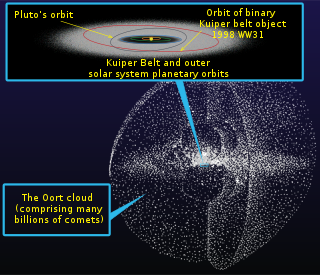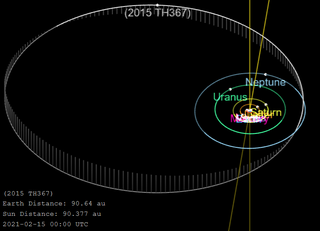Related Research Articles

A comet is an icy, small Solar System body that warms and begins to release gases when passing close to the Sun, a process called outgassing. This produces an extended, gravitationally unbound atmosphere or coma surrounding the nucleus, and sometimes a tail of gas and dust gas blown out from the coma. These phenomena are due to the effects of solar radiation and the outstreaming solar wind plasma acting upon the nucleus of the comet. Comet nuclei range from a few hundred meters to tens of kilometers across and are composed of loose collections of ice, dust, and small rocky particles. The coma may be up to 15 times Earth's diameter, while the tail may stretch beyond one astronomical unit. If sufficiently close and bright, a comet may be seen from Earth without the aid of a telescope and can subtend an arc of up to 30° across the sky. Comets have been observed and recorded since ancient times by many cultures and religions.

The Oort cloud, sometimes called the Öpik–Oort cloud, is theorized to be a vast cloud of icy planetesimals surrounding the Sun at distances ranging from 2,000 to 200,000 AU. The concept of such a cloud was proposed in 1950 by the Dutch astronomer Jan Oort, in whose honor the idea was named. Oort proposed that the bodies in this cloud replenish and keep constant the number of long-period comets entering the inner Solar System—where they are eventually consumed and destroyed during close approaches to the Sun.

The scattered disc (or scattered disk) is a distant circumstellar disc in the Solar System that is sparsely populated by icy small Solar System bodies, which are a subset of the broader family of trans-Neptunian objects. The scattered-disc objects (SDOs) have orbital eccentricities ranging as high as 0.8, inclinations as high as 40°, and perihelia greater than 30 astronomical units (4.5×109 km; 2.8×109 mi). These extreme orbits are thought to be the result of gravitational "scattering" by the gas giants, and the objects continue to be subject to perturbation by the planet Neptune.

In astronomy, the Hills cloud is a vast theoretical circumstellar disc, interior to the Oort cloud, whose outer border would be located at around 20,000 to 30,000 astronomical units (AU) from the Sun, and whose inner border, less well defined, is hypothetically located at 250–1500 AU, well beyond planetary and Kuiper Belt object orbits—but distances might be much greater. If it exists, the Hills cloud contains roughly 5 times as many comets as the Oort cloud.

Tyche was a hypothetical gas giant located in the Solar System's Oort cloud, first proposed in 1999 by astrophysicists John Matese, Patrick Whitman and Daniel Whitmire of the University of Louisiana at Lafayette. They argued that evidence of Tyche's existence could be seen in a supposed bias in the points of origin for long-period comets. More recently, Matese and Whitmire re-evaluated the comet data and noted that Tyche, if it existed, would be detectable in the archive of data that was collected by NASA's Wide-field Infrared Survey Explorer (WISE) telescope. In 2014, NASA announced that the WISE survey had ruled out any object with Tyche's characteristics, indicating that Tyche as hypothesized by Matese, Whitman, and Whitmire does not exist.

2012 DR30 is a trans-Neptunian object and centaur from the scattered disk and/or inner Oort cloud, located in the outermost region of the Solar System. The object with a highly eccentric orbit of 0.99 was first observed by astronomers with the Spacewatch program at Steward Observatory on 31 March 2009. It measures approximately 188 kilometers (120 miles) in diameter.
In observational astronomy, the observation arc of a Solar System body is the time period between its earliest and latest observations, used for tracing the body's path. It is usually given in days or years. The term is mostly used in the discovery and tracking of asteroids and comets. Arc length has the greatest influence on the accuracy of an orbit. The number, spacing of intermediate observations, and timestamps have a lesser effect.

C/2013 V5 (Oukaimeden) is a retrograde Oort cloud comet discovered on 12 November 2013 by Oukaimeden Observatory at an apparent magnitude of 19.4 using a 0.5-meter (20 in) reflecting telescope.

C/2013 US10 (Catalina) is an Oort cloud comet discovered on 31 October 2013 by the Catalina Sky Survey at an apparent magnitude of 19 using a 0.68-meter (27 in) Schmidt–Cassegrain telescope. From September 2015 to February 2016 the comet was around apparent magnitude 6. The comet took around a million years to complete half an orbit from its furthest distance in the Oort cloud and should be ejected from the Solar System over many millions of years.

C/2017 K2 (PanSTARRS) is an Oort cloud comet with an inbound hyperbolic orbit, discovered in May 2017 at a distance beyond the orbit of Saturn when it was 16 AU (2.4 billion km) from the Sun. Precovery images from 2013 were located by July. It had been in the constellation of Draco from July 2007 until August 2020. As of June 2022, the 3-sigma uncertainty in the current distance of the comet from the Sun is ±6000 km.

C/2018 C2 (Lemmon) is a hyperbolic comet. It was first observed on 5 February 2018 by the Mount Lemmon Survey conducted at the Mount Lemmon Observatory near Tucson, Arizona, in the United States. The discovery was announced on 4 March 2018 along with another hyperbolic object, A/2017 U7. Based on the absolute magnitude of 15.1, it may measure several kilometers in diameter. On 22 March 2018 it was determined to be a hyperbolic comet.

2015 TH367 is a trans-Neptunian object approximately 220 kilometers in diameter. As of 2021 it is approximately 90 AU (13 billion km) from the Sun. At the time of its announcement in March 2018, it was the third most distant observed natural object in the Solar System, after Eris and 2014 UZ224.

C/2018 F4 (PanSTARRS) is a hyperbolic comet. It was discovered on 17 March 2018 when it was beyond the orbit of Jupiter, 6.4 AU (960 million km) from the Sun. It was quite far from the Sun and turned out to simply be an asteroidal object that was discovered before cometary activity was noticeable. As perihelion is inside the orbit of Jupiter, this object should become more active. In April 2018 it was determined to be a hyperbolic comet. Given that the incoming velocity was similar to that of an Oort cloud object, we can very confidently say that it is not of interstellar origin. C/2018 F4 fragmented around August 2020.

C/2014 UN271 (Bernardinelli–Bernstein), simply known as C/2014 UN271 or Comet Bernardinelli–Bernstein (nicknamed BB), is a large Oort cloud comet discovered by astronomers Pedro Bernardinelli and Gary Bernstein in archival images from the Dark Energy Survey. When first imaged in October 2014, the object was 29 AU (4.3 billion km; 2.7 billion mi) from the Sun, almost as far as Neptune's orbit and the greatest distance at which a comet has been discovered. With a nucleus diameter of at least 120 km (75 mi), it is the largest Oort cloud comet known. It is approaching the Sun and will reach its perihelion of 10.9 AU (just outside of Saturn's orbit) in January 2031. It will not be visible to the naked eye because it will not enter the inner Solar System.